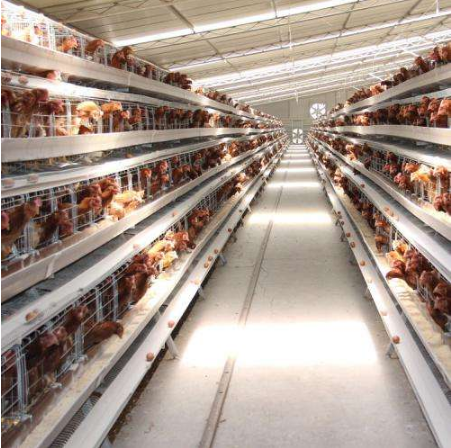In the case of a large number of chickens, it is more advantageous to use chicken cages in poultry farming equipment to raise chickens. So how much do you know about the ventilation of chicken houses? More ventilation is also the need for intensive farming and large-scale aquaculture development. There are more chickens, the density is higher, and the environment is deteriorating. In order to adjust the air quality in the house, there is ventilation and mechanical ventilation.
The purpose of ventilation in the chicken poultry farming equipment for sale: the sole purpose of ventilation is to change the air, that is, to use the mechanical force to complete the timing and quantitative exchange of the air in the chicken house with the outside world, so as to achieve the professional requirements and economic purposes of healthy farming. Spring, autumn and winter, when it comes to ventilation, everyone thinks that the oxygen content in the chicken house is not less than 19.6- 19.8%, ammonia, carbon monoxide, carbon dioxide, hydrogen sulfide, sulfur dioxide, dust, smoke, etc. do not exceed the standard. For cages, this is easy to do, and the minimum ventilation is 1/4-1/3 or even less than the ground and net culture. Timely clearing of manure, small ventilation, increased stocking density, and low energy consumption are the biggest advantages of cage cultivation in the cold season. At this time, ventilation is not only about changing the air, but also considering the cost of ventilation, because the heat and humidity in the house are taken away when the air is ventilated. Therefore, in the heating season, the use of minimum ventilation has extremely important economic significance, because wind turbines, humidification, and heating are all costly. It is necessary to consider it comprehensively. It is not the ultimate goal to raise a chicken. It is only possible to make more money. Ventilation in the
summer is considered to eliminate the excess heat in the house as much as possible, and to produce a wind-cooling effect on the chicken as needed, in order to facilitate the chicken to obtain a more comfortable body temperature.
Temperature difference control: As long as the longitudinal ventilation is adopted in the chicken house, the temperature difference is inevitable; no matter what heating and ventilation mode is adopted in the cage house, the temperature difference between the upper and lower layers is inevitable, which is a basic physical phenomenon. To solve the temperature difference problem, we must first solve the ventilation problem, which involves wind pressure, wind speed and
wind speed. We have no way to smooth the temperature difference. We have to find a way to reduce the temperature difference. The temperature difference I am talking about here is the large temperature difference. It is a large temperature difference (temperature difference of more than 2-3 °C) that directly affects the growth and development of chickens and even causes the chickens to be killed by heat.
Seeking somatosensory comfort: Somatosensory temperature is a kind of biological detection and satisfaction of the chicken to the external environment. Whether the body temperature can meet the needs and best needs of the chicken depends on our grasp of the environmental control. For example: the same temperature, the wind speed is not the same, the chicken feels different; the same temperature and wind speed, the humidity is different, the chicken feels different; to
find a suitable temperature in the chicken house, so that the chicken can be more health.
